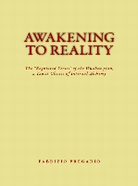Taoist Internal Alchemy
and the Awakening to Reality (Wuzhen pian)
Reproduced from:
Awakening to Reality: A Taoist Classic of Internal Alchemy
Translated by Fabrizio Pregadio
Golden Elixir Press, 2009
Paperback ● Kindle ● PDF
The Wuzhen pian (Awakening to Reality) is one of the most important and best-known Taoist alchemical texts. Written in the 11th century, it describes in a poetical form several facets of Neidan, or Internal Alchemy. Read more on this book.
 This page is part of a series on the Awakening to Reality. See the complete index.
This page is part of a series on the Awakening to Reality. See the complete index.
2. Doctrinal Sources
Internal Alchemy is not a "school" of Taoism, but rather one of its major traditions, and as such it has existed in forms that differ, sometimes considerably, from one another. Certain forms of Internal Alchemy give priority to its purely spiritual aspect, while others emphasize the performance of practices. Like all traditional doctrines, moreover, Internal Alchemy defies attempts of systematization. For these reasons, a full description of Taoist Internal Alchemy is beyond the scope of this introduction. The following pages intend only to provide a few basic tools that should make the understanding of Awakening to Reality easier.
Index of this article
1. Zhang Boduan and His Work
2. Doctrinal Sources
3. The Elixir
4. Cosmological Emblems
5. Final Remarks
Related pages
Texts of Internal Alchemy contain repeated references or allusions — for example, by the use of certain distinctive terms — to the major sources of Taoist thought, namely the Daode jing (Book of the Way and its Virtue) and the Zhuangzi (Book of Master Zhuang). In particular, the Daode jing — which virtually all Taoists in China have considered to be the fountainhead of the entire Taoist tradition — has provided alchemy with essential doctrinal foundations: the view of the Dao (the Way), the notion that the generation of the world by the Dao is best described as a sequence of stages, and the basic principle of "returning to the Dao" (fandao). The above-mentioned Chen Zhixu says in his major work, the Jindan dayao (Great Essentials of the Golden Elixir, chapter 2): "The Way of Laozi is the great Way of the Golden Elixir."
In the "Regulated Verses" of his Awakening to Reality, Zhang Boduan refers several times to the Daode jing (see especially Poem 4, lines 1-2; Poem 6, line 3; and Poem 12, line 5). The same is true of the Zhuangzi, a work that has provided countless Taoist authors with both poetical inspiration and technical terms (examples of both are found in Poem 5, line 2, and Poem 6, lines 5-6). While these references might appear to be occasional, or even superficial, they reflect a distinctive aspect of Chinese literature, especially philosophical or religious: it is often by means of short and apparently casual allusions that authors signal their bonds to specific doctrines or teachings.
Just wait until your work is achieved to have audience at the Northern Portal, and in the radiance of a ninefold mist you will ride a soaring phoenix.
![]() Wuzhen pian (Awakening to Reality, ca. 1075)
Wuzhen pian (Awakening to Reality, ca. 1075)
Zhang Boduan is said to have devoted himself to Chan (Zen) Buddhism late in life, and one of the works that are ascribed to him, the Wuzhen pian shiyi (Supplement to the Awakening to Reality), abound in Buddhist terminology. Like many other Neidan texts, the Awakening also contains Buddhist expressions, for example in the first poem. Connections between Taoism and Buddhism are, in fact, indicated in a most explicit way by the title of Zhang Boduan's work, which combines a typically Buddhist term, wu or "awakening," with a typically Taoist term, zhen or "reality, truth, perfection." (The term wu is better known in the West in its Japanese pronunciation, satori, which denotes the "awakening" in the Chan/Zen Buddhist tradition.) These connections are perhaps best explained by the fact that Neidan is ultimately a way of seeing, and therefore recognizes the validity of any formulation of doctrinal points that are analogous to its own doctrines, often crossing borders among different traditions. Buddhism is one of the traditions — in fact, the most important one — from which Neidan has acquired concepts and vocabulary.
The same is fundamentally true of Confucian ideas, even though the "Regulated Verses" do not contain examples of their use; in fact, an allusion to Confucianism found at the beginning of the text (Poem 1, line 2) is distinctly negative. This allusion, however, concerns the definition of the highest ideal for the human being, a subject on which Confucianism and Taoism differ. In other contexts, alchemical texts do contain Confucian terminology, and even short quotations from Confucian texts, for reasons analogous to those mentioned above with regard to Buddhism. Examples will be found in the translations of passages from Liu Yiming's commentary, where the author freely uses Confucian vocabulary (for example, "innate knowledge," or liangzhi, and "innate capacity, or liangneng) in a Neidan context.
As far as alchemical texts are concerned, Zhang Boduan's main source is, beyond any doubt, the ☞ Cantong qi (The Seal of the Unity of the Three). This work, traditionally dated to the 2nd century CE but in fact written — or at least completed — a few centuries later, has supplied the entire Neidan tradition with doctrines, imagery, terminology, and basic models of practice. The Awakening to Reality has even been called a commentary on the Cantong qi. This definition is probably an overstatement, but it is a fact that the "Regulated Verses" contain many allusions to the Cantong qi, and that at least one passage of the text (Poem 5, lines 5-6) would be hardly comprehensible without reading a parallel passage in the Cantong qi.
◀ Back: 1. Zhang Boduan and His Work
Next: 3. The Elixir ▶








